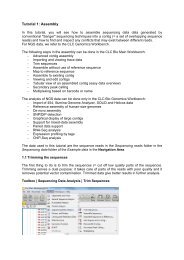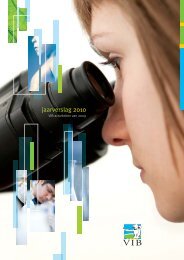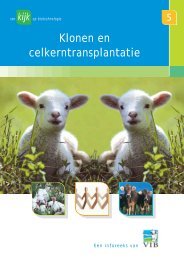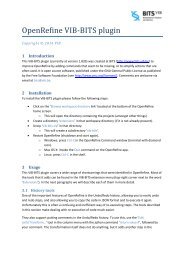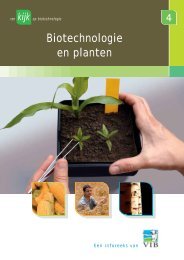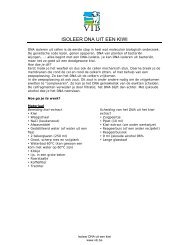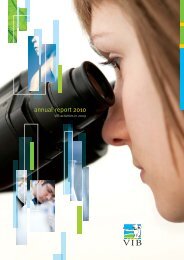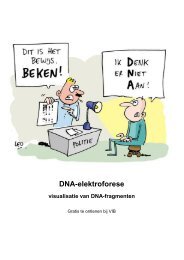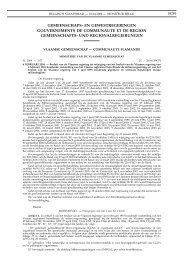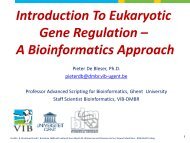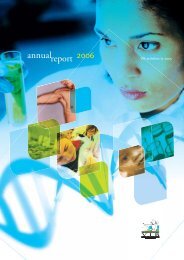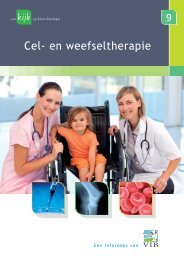Biosafety in the laboratory - VIB
Biosafety in the laboratory - VIB
Biosafety in the laboratory - VIB
Create successful ePaper yourself
Turn your PDF publications into a flip-book with our unique Google optimized e-Paper software.
4. Activities us<strong>in</strong>g plant cells<br />
Second direction<br />
First direction<br />
10. Activities <strong>in</strong> which characterised<br />
genetic material is or has<br />
been added<br />
11. Activities <strong>in</strong> which genetic<br />
material is or has been added<br />
that has not been<br />
characterised<br />
Activities <strong>in</strong> which genetic material is or has been added that<br />
has not been characterised<br />
Activities <strong>in</strong> which characterised genetic material<br />
is or has been added<br />
a. The donor produces a tox<strong>in</strong> of T3 L2 L3<br />
respectively class T2 L1 L2<br />
T1 L1 L2<br />
b. The donor is, or has been developed from, Risk group 4 L4 L4<br />
a for eucaryotic cells <strong>in</strong>fectious virus of Risk group 3 L3 L3<br />
respectively risk group 4, 3 or 2, and <strong>the</strong> Risk group 2 L2 L2<br />
viral sequences that have been brought <strong>in</strong>to<br />
<strong>the</strong> host can give rise to <strong>the</strong> formation of<br />
autonomously replicat<strong>in</strong>g virusparticles<br />
c. The donor is, or has been developed from, Risk group 4 L1 L2<br />
a defect for eucaryotic cells <strong>in</strong>fectious virus of Risk group 3 L1 L2<br />
respectively risk group 4, 3 or 2, and <strong>the</strong> viral Risk group 2 L1 L2<br />
sequences that have been brought <strong>in</strong>to <strong>the</strong><br />
host cannot give rise to <strong>the</strong> formation of<br />
autonomously replicat<strong>in</strong>g virusparticles<br />
d. The donor is a non-viral pathogen of Risk group 4 L1 L2<br />
respectively Risk group 3 L1 L2<br />
Risk group 2 L1 L2<br />
e. The donor is an organism of biological risk L1 L2<br />
group 1, or a plant or an animal<br />
f. The sequence conta<strong>in</strong>s genetic <strong>in</strong>formation T3 L2 L3<br />
that codes for <strong>the</strong> production of a tox<strong>in</strong> of T2 L1 L2<br />
respectively class T1 L1 L2<br />
g. The sequence conta<strong>in</strong>s genetic <strong>in</strong>formation Risk group 4 L4 L4<br />
for <strong>the</strong> formation of a for eucaryotic cells Risk group 3 L3 L3<br />
<strong>in</strong>fectious virus, of respectively risk group 4, Risk group 2 L2 L2<br />
3 or 2 and <strong>the</strong> viral sequences that have<br />
been brought <strong>in</strong>to <strong>the</strong> host can give rise to<br />
<strong>the</strong> formation of autonomously replicat<strong>in</strong>g<br />
virusparticles<br />
h. The sequence conta<strong>in</strong>s genetic <strong>in</strong>formation Risk group 4 L1 L2<br />
for <strong>the</strong> formation of a defect for eucaryotic Risk group 3 L1 L2<br />
cells <strong>in</strong>fectious virus, of respectively risk Risk group 2 L1 L2<br />
group 4, 3 or 2 and <strong>the</strong> viral sequences that<br />
havebeen brought <strong>in</strong>to <strong>the</strong> host cannot give<br />
rise to <strong>the</strong> formation of autonomously<br />
replicat<strong>in</strong>g virusparticles:<br />
i. The sequence conta<strong>in</strong>s genetic <strong>in</strong>formation L1 L2<br />
that codes for a hazardous gene product,<br />
o<strong>the</strong>r than <strong>in</strong> f.<br />
j. The sequence does not conta<strong>in</strong> genetic <strong>in</strong>for- L1 L2<br />
mation that codes for a hazardous gene product<br />
Guidel<strong>in</strong>es for <strong>the</strong> classification of GMO-activities 61



